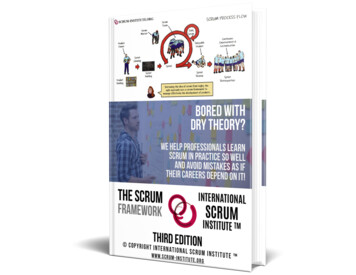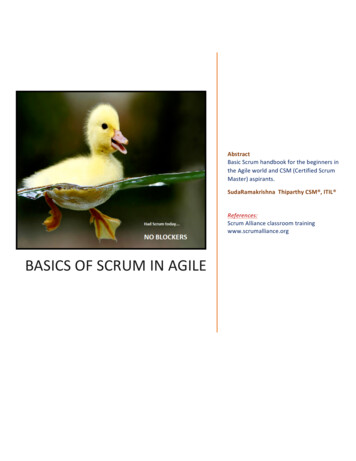
Transcription
Agile Testing in ScrumA Study of Major Factors for Successful Agile TestingImplementations in the View of Agile TestersSamira AzarkerdarSubject: Information SystemsCorresponds to: 30 CreditsPresented: VT 2018Supervisor: Dr.Ruth LochanExaminer: Prof. D. M. HaftorDepartment of Informatics and Media
AbstractAgile testing, one of the most pivotal aspects of Agile software development, was first introducedin 2003. Since then, companies have been moving towards the ‘Agile way of working’ which is quitechallenging indeed, especially for large companies used to working with traditional methodologies wheretesting is conducted only prior to final product release. In contrast, Agile methodology requires that testingbe done after each iteration to detect bugs as quickly as possible. Therefore, traditional companies find ithard to adapt to the more recent, different methodologies. This case study aimed to illuminate the mainfactors which are of paramount importance in the Agile testers’ perspective for the successful Agile testingimplementation in an organization using Agile testing methodology with Scrum framework. These factorswill be particularly useful for companies which intend to change their current methods and employ Agileones to detect bugs as quickly as possible, accelerate product delivery, and elevate product quality. In thisstudy, Cybercom as a company that aspires to interact effectively with customers and readily adapt itselfwith their feedback was selected. Data were collected through semi-structured interviews with Agile testersof Cybercom Group in Sweden, who presented their experiences about implementing Agile tests and madeit possible for the researcher to collect empirical data and to evaluate methods of Agile testing in real Scrumteams. The interviews were transcribed, and thematically investigated. The findings indicated that (1) theimportance of Agile testers’ skills, (2) the importance of automated testing usage and its ‘Dos and Don’ts’and (3) types of Scrum-based Agile tests and their implementation are main factors in Agile testers’perspective in successful Agile testing implementation. Recommendations on how these factors may beused to increase the overall efficiency are also presented. The researcher hopes to motivate companies thatuse Agile testing to focus even further on constructive interaction with customers and adapt more easilywith customer feedback. Based on the findings of this study, some suggestions regarding Agile testing forthe future projects were presented.Keywords: Agile Testing, Agile Software Development, Agile Testers, Scrum framework, AutomatedTesting.i
Table of ContentsAbstracti1.1Introduction1.1.Testing in Agile Methodology21.2.Who Is an Agile Tester?21.3. Scrum Framework31.4. Research Problem31.5. Purpose of the study1.5.1. Why Cybercom Group?441.6. Limitations41.7. Disposition52. Background: Agile testing application62.1. Agile Testing Quadrants2.1.1. Team-Supporting Tests2.1.2. Product-Critiquing Tests6672.2. Agile Testing Methods in Scrum2.2.1. Behavior Driven Development (BDD)2.2.2. Acceptance Test-Driven Development (ATDD)2.2.3. Exploratory Testing2.2.4. Session-based Testing778993. Literature Review114. Method164.1. Explorative research164.2. Data Collection Methodology164.3. Interview Method164.4. Thematic Analysis184.5. Method of data analysis194.6. Reliability and Validity215. Themes5.1. The importance of Agile tester’ skills5.1.1. Testers’ qualifications in accomplishing their determined roles222222ii
5.1.2. Testers’ tendency and their Reasons in using Agile methodology235.2. The importance of automated testing usage and its ‘Dos and Don’ts’5.2.1. Automated testing tools features5.2.2. Various testing tools2424255.3. Types of Scrum-based Agile tests and their implementation5.3.1. The significance of Scrum method5.3.2. Various Scrum tests selection5.3.3. Agile tests in an actual performing252627286. Analysis316.1. The importance of Agile tester’ skills6.1.1. Testers’ qualifications in accomplishing their determined roles6.1.2. Testers’ tendency and their Reasons in using Agile methodology3131316.2. The importance of automated testing usage and its ‘Dos and Don’ts’6.2.1. Automated testing tools features6.2.2. Various testing tools3232336.3. Types of Scrum-based Agile tests and their implementation6.3.1. The significance of Scrum method6.3.2. Various Scrum tests selection6.3.3. Agile tests in an actual performing333333347. Discussion358. Conclusion388.1. Answer to the research question388.2. Suggestion398.3. Experience of research408.4. Further research40References:42Appendix A : Interview questions and answers45Appendix B: List of 205 articles56iii
List of Figures:Figure 1: Agile Testing Quadrants . 6Figure 2: Behavior Driven Development (BDD) . 7Figure 3: Acceptance Test-Driven Development (ATDD) . 8Figure 4: Exploratory Testing . 9Figure 5: Session-based Testing . 9List of Tables:Table 1: Literature review search criteria .11Table 2: Questions of semi-structured interviews with Agile testers in Cybercom. .18Table 3: Final themes .21Table 4: Roles of testers .23Table 5: Management of bugs .23Table 6: Testers’ tendency and their Reasons in using Agile methodology .24Table 7: Advantages of testing tools .24Table 8: Disadvantages of testing tools .25Table 9: Various testing tools .25Table 10: Method of choice .26Table 11: Technical debt.26Table 12: Use of Test-driven development / Behavior driven development .27Table 13: Use of Acceptance testing .27Table 14: Uses of Capacity test/ Functionality test .28Table 15: Performing tests .29Table 16: Product validate.30Table 17: Test cases .30iv
1.IntroductionAgile software development emerged about twenty years ago and was immediatelyrecognized as a significant software development model. Agile methodology has become knownfor being often enabling of adaptive planning, rapid product delivery, timely customer service, andfor its capacity for constant improvement (Martin, 2003). The most important advantage of Agilemethodology, however, is arguably its ability to immediately respond to change (Qasymphony,2018). There are several varying types of Agile frameworks such as Scrum, Kanban, Extremeprogramming, Lean software development, and more. In 2001, the Agile manifesto was publishedby a group of independent thinkers called the Agile Alliance (Highsmith, 2001). The manifestoconsists of 4 principles including:(1) Individuals and interactions over processes and tools:The first principle emphasizes the importance of communication, humanity and problemsolving. When individuals’ work is characterized by flexibility, processes go forward moresmoothly. Processes and tools are necessary elements for success in any project. Agile testing,therefore, not only does not overlook the significance of processes and tools but also helpsprocesses go forward simply and efficiently. Testers use automated testing tools in order toincrease efficiency and effectiveness. In actuality, the environment of Agile testing is highlycustomer-oriented and flexible enough to adopt new methods and ideas (Software TestingFundamentals, 2018).(2) Working software over comprehensive documentation:The idea behind this value is that working with functional software invariably leads toprogress and development. Agile testing does not promote the elimination of comprehensivedocumentation altogether; however, it demands that documentation should not hinder the testingprocess. For instance, Unit testing and Integration testing compose the software documentationsof the system (Software Testing Fundamentals, 2018). In addition, a decisive factor here is thatduring the testing process, the progress of documentation with regards to achieving the objectiveis not evaluated.(3) Customer collaboration over contract negotiation:The third value refers to effective collaboration between developers, testers and customers,which is commenced by having extensive conversations. The idea is that a face-to-faceconversation with mutual trust is more effective in helping the testers have a better grasp of thecustomers’ demands. Agile testers can help customers and developers arrive at a common language(Software Testing Fundamentals, 2018).(4) Responding to change over following a plan:The last value encourages acceptance of change and adapting to it for the simple reasonthat changes can and will occur at any stage of the project life cycle. No one is able to stop changes1
from happening; therefore, Agile testing embraces change and aims to turn it to the customers’advantage. Change in basic requirements is commonly a tester’s nightmare, however; Agile testersare instructed and expected to welcome changes. Moreover, it must be noted that following thepre-determined plan is essential for any project to succeed, and projects that do not follow a clearplan are likelier to fail. It is very important for Agile testers to know what happened before andwhat is going to happen through guesswork. Agile testing does not eliminate the project plan, butit requires that no fixed test plan be in place. Agile testers need to be flexible and should respondto customers' needs and requested changes; there must be proper conditions for new features to beadded seamlessly or for existing features to be removed at any given time to achieve customersatisfaction (Software Testing Fundamentals, 2018). But what is Agile testing?1.1.Testing in Agile MethodologyAgile testing was created by Brian Marick in 2003. It is a customer-facing approach totesting, meaning that products are tested more often and there is more focus on the final productin order for Agile testers to be able to assess and improve it in simpler fashion (Crispin et al. 2009).Developers use Test-Driven Development (TDD) in order to write quality production codes. WithTDD, developers write the test first, and in case they detect failures, they then write additionalcodes to allay the issues and proceed to the next functionality. Developers also write integrationtests in order to make sure that the various sections of the code work together smoothly (Crispinet al. 2009).Testing in traditional software development was only conducted when work on the productwas finished and it was slated to be released. In traditional project coding, more time was neededand development teams spent longer periods in code-and-fix cycles; this led to situations wheretesting got squished (Crispin et al. 2009). Contrastingly, as mentioned before, testing in Agilesoftware development is conducted for each iteration. In this way, developers hardly ever get aheadof testers because the work on no feature is considered done until it has been completely tested.1.2.Who Is an Agile Tester?Agile teams work dynamically, focus on doing their best, and continually seekimprovements in order to deliver the best final product. An Agile tester is a member of an Agileteam whose main duty is to carry out tests and assess the quality of the work in progress. Agiletesters need to respond properly to change, have effective cooperation with colleagues in thetechnical and business departments, and clearly, understand testing concepts completely.Crucially, Agile testers should have adequate technical skills, know how to do efficient team work,be absolutely willing to learn, and feel obligated to deliver the products to customers in a timelymanner (Crispin and Gregory 2009). Some suggest that having the right attitude is more importantthan technical skills. Crispin and Gregory assert that, “Without the attitude, the skill is nothing”(Crispin and Gregory 2009). Testers are customer-focused; this means that, in addition toconsidering the proverbial big picture, they should look at the application through a customer’spoint of view. Agile testers tend to help and support developers and customers alike; that is, theywork cross-functionally, therefore they should not limit themselves only to solving test-related2
problems. In brief, testers’ main function is to supervise what is and/or is not working in theproduct (Crispin and Gregory 2009).Testers in Agile teams have a crucial role in approving the code before it goes intoproduction. Some of the key characteristics in all Agile testers are creativity, openness to ideas,willingness to do anything it takes to achieve higher quality, and focus on the customers’requirements. Good testers tend to understand precisely where codes fail and are aware of theavailable solutions to overcome failures (Crispin et al. 2009).There are 10 principles of Agile testers including (1) providing continuous feedback,(2)delivering value to the customer,(3) enabling face-to-face communication, (4) Having courage toadmit the mistakes, (5)Keeping it simple or applying a simple approach, (6)Practicing continuousimprovement, (7) responding to changes, (8)self-organizing,(9) focusing on people, and (10)enjoying what they do.1.3. Scrum FrameworkThe Agile framework Scrum was created by Ken Schwaber and Jeff Sutherland in the early1990s. The term Scrum in software development refers to methods that emphasize sets of values,practices and empirical processes. Scrum is an iterative framework, with every iteration startingwith sprint planning in order to determine what the team needs to do through the iteration. Teammembers work cross-functionally and, at the end of each iteration, the Scrum team should deliver“an increment of potentially shippable product functionality” (Schwaber 2004, p 12).One of the main differences between Scrum and Waterfall (one of the traditionalmethodologies) is that in the former, requirements are well-defined at the beginning of each sprint,several tests are carried out within an acceptable timeframe, and the detected bugs are fixed duringeach sprint to simplify matters. Contrastingly, in waterfall, testing and debugging are performedbefore the final release, while the heavy documentation in this framework often means that makingany subsequent changes is more complicated (Schwaber,2004).There are several elements that distinguish Scrum from other Agile frameworks including(1) development and confirmation of codes by the Agile team, (2) testing codes in testenvironments and deploying the product in the production environment and (3) acceptance criteriaare based on communications between the Agile team and stakeholders (Schwaber, 2004). Thereare also several Agile testing methods in Scrum encompassing (1) behavior driven development(BDD), (2) acceptance test-driven development (ATDD), (3) exploratory testing, and (4) sessionbased testing. Researcher would explain more about them in chapter 2 sections 2.2.1.4. Research ProblemIn traditional methods, tests are conducted right before product release, which means thattesters would have to deal with a high amount of documentation during testing, would need muchmore time to detect possible bugs and would develop unwanted stress in testers (Crispin et al.2009). Because of those weaknesses, researchers try to find ways to tackle such difficulties. Theadvent of Agile testing in 2003 opened a new horizon for testers and developers to address theseweaknesses. Therefore, these days, most companies are inclined to employ an Agile testing3
method, one which allows them to perform multiple tests during each sprint, thereby detecting anyexisting bugs much earlier than in older methods. This process leads to increased product quality(Crispin et al. 2009). This project is an attempt to investigate the main factors which are ofparamount importance in the Agile testers’ perspective for the successful Agile testingimplementation in an organization using Agile testing methodology with Scrum framework, whichshould be particularly useful for companies which intend to exchange their current methods forAgile ones in order to quicken the process of finding bugs and product delivery, and createconditions in which constant improvement is highly facilitated. Although the Agile testers areinseparable part of Agile testing projects, little was known about Agile testing implementation andimportant factors involved from their standpoints.1.5. Purpose of the studyContinuing with the problem introduced in the previous section and because the idea ofAgile testers in Agile testing implementation was overlooked by former researchers, the aim ofthis thesis is investigating the important factors for successful Agile testing implementation in theview of Agile testers. To fulfill the purpose of the study, the IT Company- Cybercom Group- asan Agile company was recruited in order to clarify what factors are required to plan and realizeAgile testing in the view of testers in an Agile company that uses Scrum frame work. Furthermore,in this circumstance, it is also relevant to provide a list of suggestions regarding how these factorsmay be used to increase the overall efficiency in the future projects.The specific research question that was formulated to achieve this research goal is: What factors are of paramount importance in the view of Agile testers for successfulAgile testing implementation in Scrum framework?1.5.1. Why Cybercom Group?Cybercom Group is the company with over 20 years of experience in information andcommunication technology. The international headquarters of Cybercom are located in Poland andIndia where it provides business services in the Nordic region such as Sweden, Finland andDenmark. Cybercom has 1,300 active employees across five countries. The main focus ofCybercom is on development of telecom tools and Agile software development projects.Cybercom prides itself on solving problems through technical expertise and sustainable solutions(www.cybercom.com, 2018). There are several reasons for choosing this company. First andforemost, this company works in the field of Agile testing and due to the simplicity ofcommunication with the company. Second, this choice could provide the chance to cooperate withthis company within the given timeframe to write this thesis.1.6. LimitationsTo address the research question, the researcher was searching a lot to find a company thatis implementing Agile methodology. Since many Agile companies did not tend to participate inuniversity research project, the process of finding a proper company was really time-consuming.Eventually, the company whose management finally agreed to granted the author access to its data4
and work on it as case study was Cybercom (an IT consulting company). Unfortunately thiscompany had no more than four testers among its personnel. It is crystal clear that a higher numberof testers could have resulted in a much simpler and more accurate data analysis in the research.1.7. DispositionChapter 2 includes a background of Agile testing application.In chapter 3, the related literature is reviewed.Chapter 4 elaborates the concept of explorative research, the data collection methodology andmethod for data analysis utilized in this study.In chapter 5, the Themes of the research on implementation of Agile tests by the Agile testers arepresented.In chapter 6, the analysis of research findings is presented.In chapter 7, the author discussed the findings extracted from interviews with the Cybercom’stesters.Chapter 8 contains the final answer to the research question of this thesis, while ideas for furtherresearch are suggested at the end.5
2. Background: Agile testing applicationIn this section, a brief introduction to the Agile testing methodology is provided.2.1. Agile Testing QuadrantsA summary of all the essential tests with regards to Agile software development as devisedby Crispin and Gregory (2009) determine Agile testing quadrants (figure 1). They conceived thereare four Agile testing matrixes and called them quadrants. The quadrant numbers follow nospecific order but only refer to whether a quadrant is Technology facing, Supporting the team etc.It is worth noting that these quadrants do not work in Waterfall. Some projects start with Q2because this quadrant contains specifications and tests that drive coding. Q4 puts the emphasis onthe structure of features. When customers are not sure about the requirements, it is better to startwith Q3 so as to use exploratory testing. These two quadrants require extensive coding. Companiesthat use Agile methodology, use the quadrants on a regular basis in order to work faster and torelease products of higher quality. The quadrants also help Agile teams have better adaptiveplanning for their testing in the subsequent sprints (ibid).Here, the author intends to briefly explain the four quadrants of Agile testing whichcomprise team-supporting tests, product-critiquing tests, business-facing tests, and technologyfacing tests.Figure 1: Agile Testing QuadrantsImage from -testing-quadrants/2.1.1. Team-Supporting TestsTests that support the team relate to product development. Tests in Q1 and Q2 are donemore often. The aim of Q1 tests is to implement test-driven development in order to helpprogrammers write the codes well. Unit tests confirm the functionality of the system andComponent tests confirm the behavior of the system. Both are automated and are based on thesame programming language as the application. The internal quality of a product is understandableby developers but, in most cases, not by business experts (Crispin and Gregory, 2009).The purpose of testing in Q2 is to support the work of the development team at a high level.This means that tests are defined in detail for the customer team, with Business facing test toimplement them at operational level. However, tests are written in such a way as to be6
comprehensible by business experts using the business language familiar to them. Moreover,business facing tests need to be automated. To sum up, quadrants 1 and 2 provide quick access theinformation and enable the team to perform equally quick troubleshooting (Crispin and Gregory,2009).2.1.2. Product-Critiquing TestsAs Crispin and Gregory (2009) mention, it can be hard for a programmer to understandwhat a customer exactly wants. The term ‘critique’ refers to suggestions for revision andimprovement. Q3 and Q4 are allocated to critiquing the delivered products. In Q3, the businessfacing test is categorized based on the experience of working with the software. The team does nothave any competition. During the implementation phase of business facing tests on products, theauthor imagines how the user works with the application. In this quadrant, humans do manualtesting i.e. testers.They also add, in quadrant 4, technology facing refers to the types of Agile tests that havea critical role in various aspects of Agile software development such as performance, robustness,and security. Before starting the coding process, it is important that programmer become familiarwith the features that are affected most by performance and security. This helps the programmerhave an easier job of designing the code based on the customers’ need.In Agile software development using Automation tools is necessary for certain types oftests such as load testing, performance testing, regression testing and integration testing. In fact, itis Automated testing that creates the test cases and test scenarios required in manual testing.2.2. Agile Testing Methods in ScrumThis section is largely inspired by a related article on Qasymphony.com (the completeaddress is mentioned under all image captions) and introduces all Agile testing methods in detailso as to facilitate the reader’s understanding of this study.2.2.1. Behavior Driven Development (BDD)Figure 2: Behavior Driven Development (BDD)Image from: guide-Agile-testing/It is a type of Agile testing that gets its inspiration from Test Driven Development (TDD).It is suitable for teams that make use of feature-focused software. Behavior driven development(BDD) is applied for high-level tests in business environments. In BDD, a set of initial7
requirements are written based on the user’s behavior which is determined through humanreadable tests. These requirements serve as a guideline for testers whose specialty is in developingtesting methods (QASymphony 2018).BDD is different from traditional testing in that it requires test cases to be written as earlyas possible and calls for them to be executed toward the development cycle. However, BDD in anAgile environment means that tests are not based on requirements, while testing happens at thesame time as development of the features (QASymphony 2018). Moreover, with Waterfallmethodology, testers are tasked with writing the test cases. Contrastingly, a BDD approach reducescommunication (or miscommunication) between the business analysts, developers and testers(QASymphony 2018).BDD testers are expected to carry out the following:1. Optimization of documents in order to keep track of the processes2. Using the Three Amigos model when team members work together3. Using a testing framework in order to define the criteria4. Using an automated testing in order to reuse tests easily (QASymphony 2018).2.2.2. Acceptance Test-Driven Development (ATDD)Figure 3: Acceptance Test-Driven Development (ATDD)Image from: guide-Agile-testing/The second type of Agile testing is Acceptance Test Driven Development (ATDD). It issimilar to BDD in that it needs to have tests written first, and in case the tests fail, codes will bewritten until the test is passed. ATDD tests are technical-facing unit tests, but ATDD tests arecustomer-facing acceptance tests. In ATDD, the user’s perfect understanding of the product is asessential as its functionality, therefore it can help increase adaptiveness (QASymphony 2018).ATDD is different from traditional methodology because it is not based on requirementsof the testing process. In Agile methodology, ATDD is a test-first methodology. It is based on userexperience with a high degree of adaptiveness. Some of the ATDD practices for Agile testersinclude: (1) Close interaction with customers in order to have a better understanding of theirexpectations, (2) Improving acceptance criteria based on customers’ demands (QASymphony2018).8
2.2.3. Exploratory TestingFigure 4: Exploratory TestingImage from: guide-Agile-testing/Exploratory testing is a functional testing method and is relatively important in Agiletesting environments (QASymphony 2018). It has been said that, “Exploratory testing is a style ofsoftware testing that emphasizes the personal freedom and responsibility of the individual testerto continually optimize the value of her work by treating test-related learning, test design, testexecution, and test result interpretation as mutually supportive activities that run in parallelthroughout the project” (Kaner.com 2018).Exploratory testing has applications in both methodologies, but the main differencebetween them is that the interaction between testers and
use Agile testing to focus even further on constructive interaction with customers and adapt more easily with customer feedback. Based on the findings of this study, some suggestions regarding Agile testing for the future projects were presented. Keywords: Agile Testing, Agile Software Development, Agile Test










